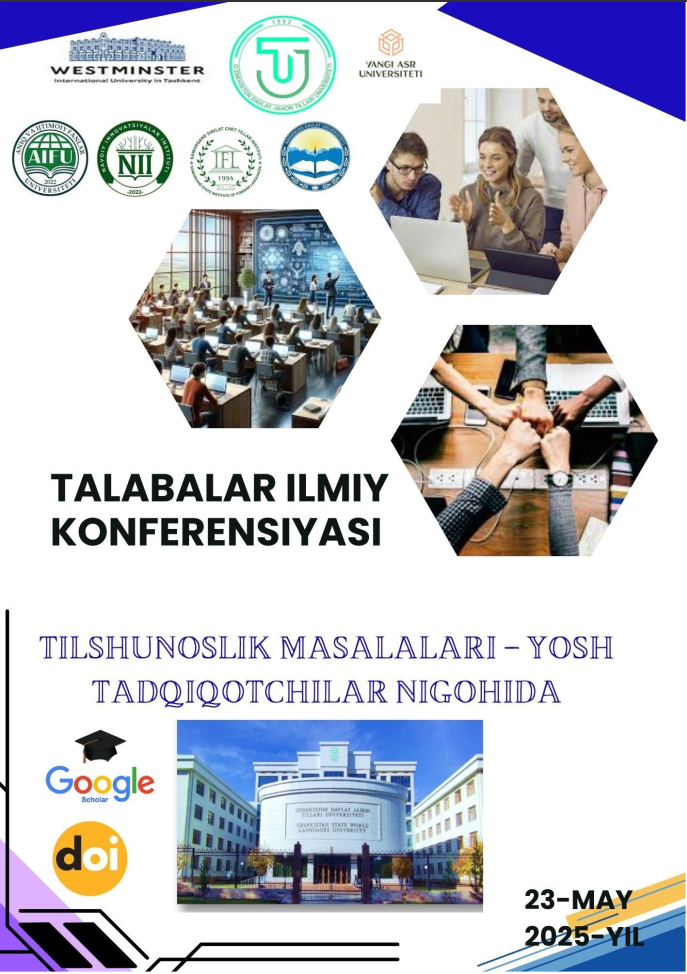DEXIS IN SCIENTIFIC TEXTS
https://doi.org/10.5281/zenodo.15547539
Kalit so‘zlar
Dexis, deixis, scientific writing, academic style, discourse analysis, reference in textsAnnotasiya
This article discusses the concept of dexis in scientific texts. Dexis, also known as deixis, refers to words and phrases that point to time, place, or person, and its use is different in scientific writing compared to spoken or informal language. In scientific texts, the use of dexis is more limited and often carefully controlled. However, some deictic expressions are still used to help guide readers through arguments, data, and interpretations. This paper shows how dexis works in scientific texts and why it matters for clarity and academic tone. It also includes examples and analysis from recent scientific articles. The goal is to help students and young researchers understand the role of dexis and improve their academic writing skills.
Foydalanilgan adabiyotlar ro‘yhati
Abulkasimovna, E. Z., & Leonidovna, M. N. (2023, March). THE LEXICAL-SEMANTICAL USAGE OF PROFESSIONAL LEXEMES IN “UTGAN KUNLAR”(" PAST DAYS") BY ABDULLA QADIRI. In International Scientific and Current Research Conferences (pp. 20-22).
Alimdjanovna, K. M. (2024). METAKOGNITIV YONDASHUV ASOSIDA INGLIZ TILINI O ‘QITISH. Бюллетень педагогов нового Узбекистана, 3(2), 113-117.
Bondi, M., & Lorés-Sanz, R. (2021). Persuasion in Specialised Discourses: Beyond Words. John Benjamins Publishing Company.
Charles, M. (2003). ‘This mystery...’: a corpus-based study of the use of nouns to construct stance in theses from two contrasting disciplines. Journal of English for Academic Purposes, 2(4), 313–326. https://doi.org/10.1016/S1475-1585(03)00048-1
El Agez, B., & Rashidova, G. I. (2024). Authentic materials for teaching writing: a critical look. O ‘zbekiston davlat jahon tillari universiteti konferensiyalari, 21-30.
Flowerdew, J. (2015). John Swales’s approach to pedagogy in English for Academic Purposes. Journal of English for Academic Purposes, 19, 35–43. https://doi.org/10.1016/j.jeap.2015.02.003
Gulomova, R. (2017). The importance of fairy tales in teaching English as a second language. Архивариус, 1(2 (17)), 27-29.
Hinkel, E. (2004). Teaching Academic ESL Writing: Practical Techniques in Vocabulary and Grammar. Lawrence Erlbaum Associates.
Hyland, K. (2002). Authority and invisibility: Authorial identity in academic writing. Journal of Pragmatics, 34(8), 1091–1112. https://doi.org/10.1016/S0378-2166(02)00035-8
Johns, A. M. (2008). Genre awareness for the novice academic student: An ongoing quest. Language Teaching, 41(2), 237–252. https://doi.org/10.1017/S0261444807004892
Rahimberdiyeva, A., & Muhtashamova, P. (2024). Teaching methods in mixed ability classes. O ‘zbekiston davlat jahon tillari universiteti konferensiyalari, 166-169.
Salager-Meyer, F. (1994). Hedges and textual communicative function in medical English written discourse. English for Specific Purposes, 13(2), 149–170. https://doi.org/10.1016/0889-4906(94)90013-2
Scollon, R., & Scollon, S. W. (2001). Intercultural Communication: A Discourse Approach (2nd ed.). Blackwell.
Soatova, G. (2024). Navigating a multicultural world: equipping teenagers with intercultural communication skills. O ‘zbekiston davlat jahon tillari universiteti konferensiyalari, 646-651.
SULTONOVA, M. (2024). On the issue of critical thinking.

